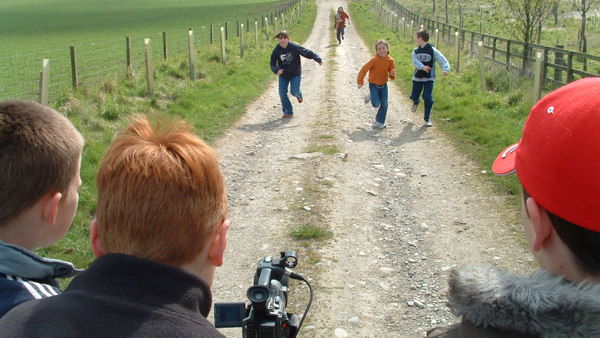Going for a take
Encourage your crew to use the following calm methodical approach to start every shot. This is the way the industry does it and it really works in class too! (Shortened version at the end, ideal for tablets and phones in the classroom).
"QUIET PLEASE"
The 1st AD or Director calls "quiet please" or "quiet on set" is better in class because it reminds those not involved that filming is taking place. It is a great way to focus the whole crew.
"READY TO GO FOR A TAKE"
(1st AD or Director) "Stand by" or "Ready to go for a take"
Anyone who is not prepared should quickly make themselves ready. With a very young crew, this call can be left out.
"SOUND?"
(1st AD or Director) To ask if the sound department is ready.
"SOUND READY"
(Sound recordist) If you have a separate microphone, check everything is set and respond with
"sound ready". If you have a separate device for recording sound, check it is recording as well, and say "sound ready" If you do not have a separate mic you could not make these calls.
"CAMERA?"
(1st AD or Director) To ask if the camera department are ready.
"SPEED"
(Camera operator)
The camera operator presses the 'record' button, and ONLY after checking the camera has been rolling for 3 seconds responds with "speed" or "camera rolling".
"MARK IT"
If an announcement and clapper are being used, this would be done now. Then look to actors to make sure they are ready, and either the 1st AD or director says:
"AND.... ACTION"
Although everyone knows what should happen next, it is a good habit for actors to take a breath and not dive straight into their line or movement as soon as they hear "Action" called, the shot will be more believable and easier to edit.
"CUT" After the action is finished, encourage your director to pause a moment before bellowing 'cut' (the camera operator should not stop rolling until they hear "cut". This helps in the edit.
Watching work back
With experience you should only need to check what you have shot under special circumstances. Once you get going - keep going!
Reasons not to watch it back
- Watching things back takes up precious time, and loses focus; unsupervised children sometimes incessantly review shots when they could be filming.
- With a little confidence and experience you will know: what you have just seen filmed, HAS been recorded, and WILL look exactly like you saw on the viewfinder.
Reasons to watch it back
- At the beginning of the day it might be valuable to check a shot or two.
- If you are working on an animation being recorded on a computer, you should watch it back to check your timing.
- It took all day to set up.
- It's a special effect shot that is difficult to assess, or you only get 'one' go at.
- It's crucial fast action, that can't be seen easily.
- You intend to slow-motion the shot.
Deleting shots
There is a temptation to delete early bad takes thinking they'll be of no use. Avoid it, there might be a little piece that will save the edit.
Clapperboard
A clapperboard - for visually identifying a shot in picture - can be a basic pad and thick marker. The key thing is to make it bold enough to be seen by the camera. Also get one of the crew (usually the 1st AD) to announce:
- The scene number
- The take number
If you have a storyboard or shot list, you can put scene numbers onto a clapperboard, then in the edit you can use these to help order your first (assembly) edit.
Log sheets
Keep a log of all the scenes shot, the number of takes and any relevant remarks such as good/not good, as well as more specific notes. This will make it easier to select takes in the edit. Also, if you have any problems, log sheets can often help you identify where the root cause lies.
Checks while filming
It can be difficult to be sure if a shot has gone well, especially if you are less confident than your class. Trust your crew, but if you don't know their ability, here's a quick check list:
- Did you see the record light on?
- Did the number counter advancing during the take?
- Did you get a chance to check the shot during the take?
- Particularly watch the background (as your team/s are often too engrossed in their own film to notice someone from another class peering through a window, etc).
- Where is the boom operator pointing the microphone, were they fidgeting during the take?
- Have you checked the sound for yourself through the headphones recently?
Rehearse
Before you record any scene, rehearse getting the camera department to watch the action, so they can input into the coverage of the scene and plan the shots in advance.
Also rehearse each shot to check the composition works well. For example: you have set up the most beautiful composition; you start to record and your characters walk into the frame but you can only see the tops of their heads! The shot is useless and you have to re-record.
Summary version
- Quiet on set
- Ready to go for a take
- Sound?
- (sound recordist responds with) Sound ready
- Camera?
- (camera operator responds with) Speed
- And action
Sound too cliched to be true? That's because it works!
Short version for tablets and phone
- Quiet on set
- Ready to go for a take ?
- Camera?
- (when the counter advancing respond with) Speed
- Action


